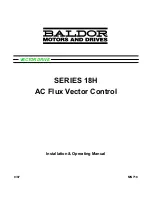
Basic Installation Procedures
12
Freedom EX 4000 Installation Guide
AC Shore Power
A source of 120 volts AC 60Hz (single-phase) and 240 volts AC
60Hz (split-phase) sine wave alternating current provides
energy to pass power through to AC loads. This source is
usually the utility grid (power company) or an AC generator. An
automatic or manual AC source selector switch can be used to
switch between the multiple sources of shore power to the
Freedom EX 4000 system.
The AC source feeding the Freedom EX 4000 must have the
neutral conductor bonded to ground. When the
inverter/charger/converter is in pass-through mode, it will lift its
internal bonding relay on the output as it passes shore power
through and will rely on the input neutral being bonded in order to
ensure that the power delivered to a sub panel is properly
bonded. See
AC Output Neutral Bonding on page 13
for more
information on bonding relay operation.
NOTE
: Throughout this guide, the term “shore power” refers to
AC input power from a utility grid, generator, or other AC source.
AC Disconnect and Over-Current
Protection Device
Most safety requirements and electrical codes require the
Freedom EX 4000’s AC and DC inputs and outputs to be
provided with over-current protection (such as circuit breakers
or fuses) and disconnect devices.
AC Input
The circuit breaker or fuse (connected through
hard wiring) that is used to supply the Freedom
EX 4000 must be rated at no more than 50A and
must be approved for use on 120 volts AC branch
circuits. The wire used between the breaker and
the Freedom EX 4000 input must be sized
adequately to carry current up to the rating of the
input breaker and in accordance with the
electrical codes or regulations applicable to your
installation.
AC Output
The circuit breaker or fuse must be rated at no
more than the rating of the input breaker in the
installation and must be approved for use on 120
volts AC branch circuits. The wire used between
the Freedom EX 4000 and the AC output breaker
must be of adequate size to match the AC input
circuit breaker’s rating. The wiring from each AC
output breaker to each of the loads must be
adequately sized to carry the current rating of the
individual AC output breaker.
Disconnect
Devices
Each system requires a method of disconnecting
the AC circuits. If the over-current protection
devices are circuit breakers, they will also serve
as the disconnects. If fuses are used, separate
AC disconnect switches will be needed ahead of
the fuses. These will have to be a branch circuit
rated for 120 volts AC and have an appropriate
current rating.
Surge
Arrester
In a marine installation, each system requires a
separate method of protecting the AC circuits
from a transient over-voltage, also called a spike
or short duration electrical surge. This protection
device is often referred to as a surge protection
device (SPD) or transient voltage surge
suppressor (TVSS). An SPD or TVSS must be
mounted on the vessel's AC circuit breaker panel
according to marine electrical codes or
regulations.
AC Distribution Panels
Most systems incorporate distribution centers both ahead of the
Freedom EX 4000 (the AC source panel) and between the
Freedom EX 4000 and the loads (the AC load panel). An AC
source panel includes a main circuit breaker, which serves as
over-current protection and as a disconnect for the AC shore
power supply line. Additional circuit breakers serve individual
circuits, one of which serves the Freedom EX 4000. The AC
load panel can incorporate an AC output circuit breaker and
breakers for individual load circuits.
AC Cabling
AC cabling includes all the wires and connectors between the
AC source and the Freedom EX 4000, as well as all AC cabling
between the Freedom EX 4000 and the AC output panels,
circuit breakers, and loads. The type and size of the wiring
varies with the installation and load. For example, in high
vibration environments, such as marine or RV applications, wire
nuts may not be acceptable, so crimp splices would be required.
In other applications, flexible multiple-strand wire may be
required. Installation codes usually specify solid or stranded,
overall size of the conductors, and type and temperature rating
of the insulation around the wire.
AC breakers and fuses must be sized to adequately protect the
wiring that is installed on the input and output AC circuits of the
Freedom EX 4000. All breakers and wiring must be sized and
connected in accordance with the electrical codes or regulations
applicable to your installation.
gives some examples of
wiring sizes based on the U.S. National Electrical Code and the
Canadian Electrical Code. These examples are based on using
a two-conductor-plus-ground copper cable rated at 60
°
C, and
assuming an ambient temperature of up to 30
°
C. Ensure that
your breakers and fuses have suitable temperature ratings for
your wiring. Other codes and regulations may also be applicable
to your installation.
Breaker
Size (A)
10A
15A
20A
30A
40A
50A
Minimum
Wire Size
(AWG)
14AWG 14AWG 12AWG 10AWG 8AWG 6AWG
Table 1 Required AC Wire Size vs Breaker Rating
Содержание Freedom EX 4000
Страница 8: ...This page is intentionally left blank 2...
Страница 10: ...This page is intentionally left blank 1...
Страница 51: ...This page is intentionally left blank 2...















































